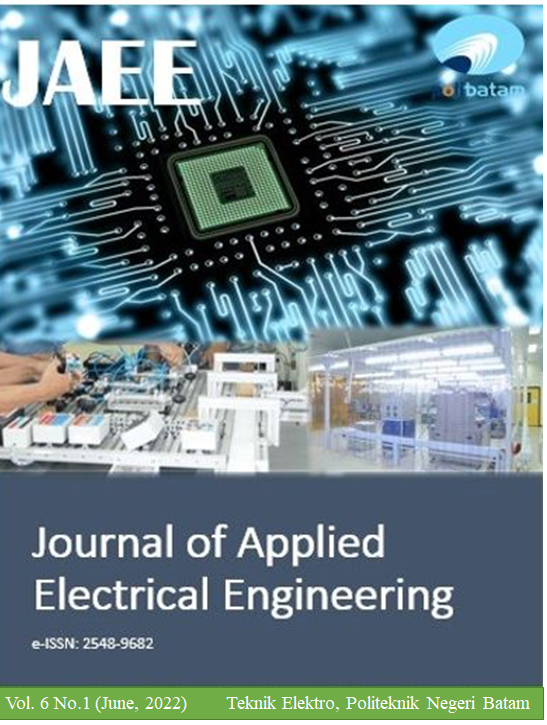Analisa Komposisi Material Barium M-Heksaferit (BAM) Berbahan Dasar Pasir Besi Pantai Cilacap dan Taluk Kuantan
DOI:
https://doi.org/10.30871/jaee.v6i1.4047Kata Kunci:
BAM PANi, Coating,Barium HexaferitAbstrak
Analyzing the material composition of iron sand from Cilacap beach and iron sand from Taluk Kuantan beach in Riau. In this research, the synthesis of barium M-Hexaferrite is made from iron sand from Cilacap beach and iron sand from Taluk Kuantan beach, Riau. In the research method, the test was carried out using composition analysis with FTIR test. The characteristics of the test using the FTIR test that the iron sand of the Cilacap beach has an Fe content of 86.53% and does not carry out refining. while the iron sand of Taluk Kuantan beach has an Fe content of 82.86% and is not purified. Based on the wave number value, BAM doped with Cu has the best wave number value and the highest transmittance value is around 92% at wavelengths from 1467.03 to 669.56 cm−1.
Unduhan
Referensi
Y. E. Gunanto, M. P. Izaak, S. S. Silaban, and W. A. Adi, "Synthesis and Characterization of Barium-Hexaferrite-Based Nanocomposite on X-Band Microwave," IOP Conference Series: Materials Science and Engineering, vol. 367, no. 1, p. 012040, May 2018, doi: 10.1088/1757-899X/367/1/012040.
S. Goel, A. Garg, H. B. Baskey, M. K. Pandey, and S. Tyagi, "Studies on dielectric and magnetic properties of barium hexaferrite and bio-waste derived activated carbon composites for X-band microwave absorption," Journal of Alloys and Compounds, vol. 875, p. 160028, Sep. 2021, doi: 10.1016/J.JALLCOM.2021.160028.
G. Tan and X. Chen, "Structure and multiferroic properties of barium hexaferrite ceramics," Journal of Magnetism and Magnetic Materials, vol. 327, pp. 87"“90, Feb. 2013, doi: 10.1016/J.JMMM.2012.09.047.
S. A. Gudkova et al., "Synthesis, structure and properties of barium and barium lead hexaferrite," Journal of Magnetism and Magnetic Materials, vol. 470, pp. 101"“104, Jan. 2019, doi: 10.1016/J.JMMM.2017.11.114.
"Studi Penyerapan Gelombang Elektromagnetik Rentang X-Band Dengan Menggunakan Penyerap PANi Konduktif Dan Barium M-Heksaferrit Terdoping Ion Zn (0,3≤X≤0,9) - ITS Repository." https://repository.its.ac.id/42877/ (accessed Jun. 29, 2022).
S. Rachmawati, S. Rachmawati, and M. Zainuri, "Pelapisan Single Layer Penyerap Gelombang Radar Dispersi Barium M-Heksaferit / Polianilin pada Rentang X-Band," Jurnal Sains dan Seni ITS, vol. 5, no. 2, pp. 2337"“3520, Nov. 2016, doi: 10.12962/j23373520.v5i2.18040.
X. Liu, M. Wang, S. Zhang, and B. Pan, "Application potential of carbon nanotubes in water treatment: A review," Journal of Environmental Sciences (China), vol. 25, no. 7, pp. 1263"“1280, Jul. 2013, doi: 10.1016/S1001-0742(12)60161-2.
Y. Li and W. Chu, "Implementation of single precision floating point square root on FPGAs," IEEE Symposium on FPGAs for Custom Computing Machines, Proceedings, pp. 226"“232, 1997, doi: 10.1109/FPGA.1997.624623.
A. Aspi, M. Malino, and B. P. Lapanporo, "Analisis Data Spektrum Spektroskopi FT-IR untuk Menentukan Tingkat Oksidasi Polianilin," PRISMA FISIKA, vol. 1, no. 2, pp. 92"“96, Sep. 2013, doi: 10.26418/PF. V1I2.3066.
A. Nanhe, G. Gawali, S. Ahire, and K. Sivasankaran, "Implementation of Fixed- and Floating-Point Square Root Using Nonrestoring Algorithm on FPGA," International Journal of Computer and Electrical Engineering, pp. 533"“537, 2013, doi: 10.7763/IJCEE. 2013.V5.767.
Unduhan
Diterbitkan
Cara Mengutip
Terbitan
Bagian
Lisensi
Authors who publish with this journal agree to the following terms:
- Authors retain copyright and grant the journal right of first publication with the work simultaneously licensed under a Creative Commons Attribution License (Attribution-ShareAlike 4.0 International (CC BY-SA 4.0) ) that allows others to share the work with an acknowledgment of the work's authorship and initial publication in this journal.
- Authors are able to enter into separate, additional contractual arrangements for the non-exclusive distribution of the journal's published version of the work (e.g., post it to an institutional repository or publish it in a book), with an acknowledgment of its initial publication in this journal.
- Authors are permitted and encouraged to post their work online (e.g., in institutional repositories or on their website) prior to and during the submission process, as it can lead to productive exchanges, as well as earlier and greater citation of published work (See The Effect of Open Access).
Open Access Policy
This journal provides immediate open access to its content on the principle that making research freely available to the public supports a greater global exchange of knowledge. Its free availability on the public internet, permitting any users to read, download, copy, distribute, print, search, or link to the full texts of these articles, crawl them for indexing, pass them as data to software, or use them for any other lawful purpose, without financial, legal, or technical barriers other than those inseparable from gaining access to the internet itself.














